Exhibitions and Fairs
57th October Salon Belgrade
By Shira Wolfe
Belgrade, or, as the Serbians call it, Beograd (“The White City”) is a magnificent city of magnificent contradictions and extremes. Throughout history, it has been known as the gateway between East and West, a lively mixture of elements from both worlds. This fall, from September 15 – October 28, the city was overflowing with the best of local and international contemporary art during Belgrade’s 57th October Salon, an annual contemporary art event that takes place in various exhibition spaces throughout the city. Curated by Gunnar B. Kvaran and Danielle Kvaran, the theme of this year’s Salon was The Marvellous Cacophony. From Yoko Ono to Bjarne Melgaard, from Olafur Eliasson to Cindy Sherman, the October Salon offered an impressive insight into what’s going on in the art world today. What’s more, the big art event was fully inclusive due to its affordability for everyone: for a mere 200 Serbian dinars (a little under €2), visitors gained access to all of the exhibition sites.
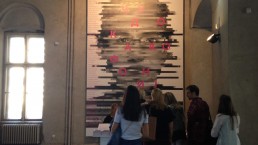
A brief history of the art scene of The White City
Belgrade is a city that has long had its own influential art traditions and movements. In the 1920s, for example, poet and art critic Ljubomir Micic founded the Yugoslav avant-garde art magazine Zenit: International Review of Arts and Culture. The main hubs of this new Yugoslav avant-garde movement Zenitism were Belgrade, Ljubljana and Zagreb. International art movements ranging from Expressionism to Futurism, Dada and Constructivism influenced Zenitism. The eclectic art movement was anti-war, anti-nationalist and anti-bourgeois, and was spread across a myriad of fields including the visual arts, graphic design, poetry, literature, film, theatre, architecture and music. The proponents of Zenitism had strong ties with avant-garde counterparts in European cities like Berlin.
By the 1970s, Belgrade had become a centre for some of the most cutting-edge experiments in performance art of the time. The legendary Student Cultural Centre (SKC) is where Marina Abramović and her fellow artists Rada Todošijević, Neša Paripović, Zoran Popović, Era Milivojević and Gergelj Urkom created some of their first performances. SKC was established as a free space for creative exploration and expression, following the student protests of 1968. The installations and performances that were created here in that period had a huge impact on the future of performance art.
The Belgrade art scene today struggles immensely with the harsh political and economic realities all around. When I first moved to Belgrade in 2016, the two main art institutions, the National Museum and the Museum of Contemporary Art, had been closed for many years. Only recently, the Museum of Contemporary Art reopened (In November 2017) after being closed for 8 years, and the National Museum reopened (in June 2018) after a period of 15 years. Yet despite the palpable struggles, the city bustles with a very particular energy and artistic life and is home to some excellent contemporary art galleries and strong artists. And more and more, the Belgrade art scene is connecting again with the international art scene. Which brings us back to the point of this article: the 2018 October Salon.
October Salon – The Marvellous Cacophony
The first October Salon took place in 1960 and was founded by the City of Belgrade. It started out as an exhibition of the best Serbian art works in the field of fine arts, and by 1967 it already encompassed a review of current tendencies in applied arts as well. October Salon remained a representation of the Serbian art scene until 2005, after which a significant shift was made towards a dialog with the international art scene. Today, October Salon represents an important art manifestation in Belgrade that combines the best of Serbian and international contemporary art in a selection of galleries across the city.
This year’s October Salon was curated by Gunnar B. Kvaran and Danielle Kvaran and was held between 15 September and 28 October 2018. The title of the exhibition, The Marvellous Cacophony, is based on the idea of diversity. As stated by the curatorial team: “This concept puts the Serbian and the Belgrade art scenes into an international context, but at the same time, refers to the complex cultural and socio-political situation in the region. (…) This Marvellous Cacophony reflects the richness of the world. It is a positive condition, creating energies that can include dissonance and even conflicting ideas and expressions.”
72 local and international artists were represented at the October Salon. “It brings together artists of all generations, origins, and sensibilities, from Larry Bell, Erró, Anselm Kiefer, Jean-Jacques Lebel, Yoko Ono, Vladimir Veličković, and Dušan Otašević, artists who have been active since the 60s to Athena Papadopoulos, Darja Bajagić, Maja Ðorđević, Jelena Mijić, Paulo Nimer Pjota, Hannah Weinberger, and Urban Zellweger, emerging figures of the current arena, taking in established artists such as Cindy Sherman, Cao Fei, Romuald Hazoumè, Fabrice Hyber, Bjarne Melgaard, Takashi Murakami, Helen Marten, Torbjørn Rødland, Tom Sachs and Anicka Yi.” – October Salon Catalogue, p. 12
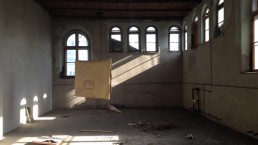
The spaces
“Each place harbors the ghosts of different species.”
– David Elliot, curator of 56th October Salon
Anyone who has spent some time in Belgrade knows that one of the city’s greatest charms is its vast variety of fascinating spaces, spaces that are often hidden to the untrained eye or are subtly masking the gems they hide inside. These spaces can seem like ordinary apartment buildings, which then turn out to contain the best bars, cultural havens and art events. Belgrade’s October Salon occupies various spaces throughout the city, and one of its strengths is that one of the anchor sites is in fact, or used to be, one such “hidden space”. Belgrade City Museum for years seemed like a beautiful building fallen into disuse that people would easily pass by. However, if you knew your stuff you would stop and open the door and enter one of the city’s best exhibition spaces.
Belgrade City Museum is located in the former Military Academy on a beautiful green street in Belgrade’s Vračar area, right next to the British Embassy. The building was long meant to become the city museum of Belgrade, but faced similar financial and planning issues as other museum institutions in the city. This meant that since 2015, there have been exhibitions there only every so often, and every time I entered this incredible space it left me aching for more – more exhibitions, more art interacting with the high ceilings and arched doorways and stone pillars and crumbling walls…
So, when I discovered that this was one of the main spaces of this year’s October Salon, I was thrilled. The building is vast, spread out over three floors, with large halls that have been left to all their glorious imperfections – crumbling walls, bared bricks, old stone pillars and large, paint-chipped windows letting in the rich October light.
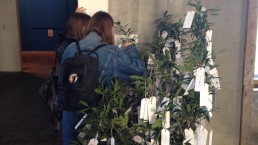
The first piece to meet the eye when entering the space was Yoko Ono’s Wish Tree – each October Salon gallery had one for visitors to write their wishes on. Next was Olafur Eliasson’s installation Your Utopia, which consists of a metal box with a red button which visitors are invited to push (creating an exciting sense of trepidation as we are invariably faced with many images of disaster connected to pushing a red button) in order to trigger the flashing bright word UTOPIA for a split second.
Video art played a significant role in this October Salon. It came in many forms and manifestations, and Belgrade City Museum was filled with video installations in the many small rooms and spaces perfect for these video installations. There was Korakrit Arunanondchai’s epic 23-minute video work With history in a room filled with people with funny names 4, a kaleidoscopic collage so powerful in its simultaneous connection and estrangement. Memory and the body, technology and the extreme ruptures in our societies around the world are woven together creating a piece that is impossible to stop watching.
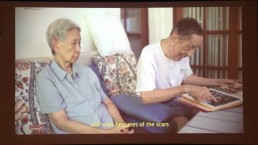
Or Jean-Jacques Lebel’s Les Avatars de Vénus (Venus Avatars): four transparent screens arranged in an open cube, onto which photographic or pictorial images of women are projected. Here, the images of women throughout the centuries and cultures, from the prehistoric Venus of Willendorf to pinups, characters in the paintings of Renaissance masters and sacred temple incarnations, morph into one another raising questions about the female form, and its idealisation and accompanying stereotypes.
In another space on the ground floor, Yoko Ono asked visitors to participate. For her Mend Piece, a table was filled with broken ceramic pottery and people were invited to mend the broken pieces as a healing action, a metaphor for individual participation in collective memory.
Beside the table, the wall was filled with yellow post-its inscribed with messages of appreciation and love to mothers. This participatory piece, My Mommy is Beautiful, is meant as a celebration of maternal love.
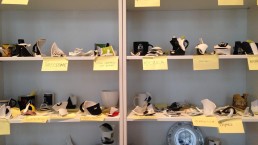
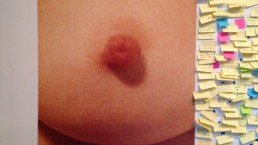
In an old hallway near the Yoko Ono installation one came face to face with Bjarne Melgaard’s series of drawings by the name of Untitled.”The beginning process of these works was the sentence ‘Everything goes wrong’ written over the drawings in Norwegian and it really did,” explains the artist in the October Salon catalogue. (p.216) This feeling of everything going wrong dominated every sphere of the artist’s life when he first moved back to Oslo from NYC and struggled with debts, working blocks, recovery from addiction and problems with friends and family, and general communication issues. These works were done in a single afternoon and then partially damaged by water leakage – but Melgaard decided to present them as they were, with damage and all. After all, the premise was “Everything goes wrong”… While most of the drawings refer to Melgaard’s personal life, his struggles and longings, one piece stands out as the artist’s crystal-clear political voice: “Free Palestine now.” A grown, bearded man is depicted suckling on the breast of an almost grotesque-looking woman who stares off into the distance with an unsettling semi-blank, semi-crazed look in her eyes.
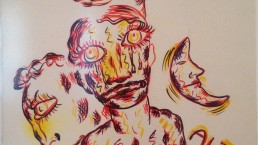
On the second floor, the visitor was met with disembodied, rhythmic, mechanical sounds coming from an open space inhabited by New York-based Serbian artist Ivana Bašić’s installations I will lull and rock my ailing light in my marble arms (hunched, pale, alienating body-like forms suspended in mid-air) and A thousand years ago 10 seconds of breath were 40 grams of dust (mechanisms which measure moments in between rhythmic impacts of stainless steel on alabaster slowly being crumbled into dust).
“The pieces here on display mirror the phases and effects of the body under pressure as it transitions from the states of being and porosity to pure density, stone, and ultimately a return to nameless fine matter. Like nesting dolls, the individual works on display each embody the cyclical stages of becoming, being, declining, and ceasing to be.” (October Salon catalogue, p.174)
The mechanical impacts echoed all throughout the second floor, even after you had left the space and continued onwards to encounter epic works such as Erró’s Silver Sable Saga, a large-format painting inspired by Marvel Comics heroine Silver Sable.
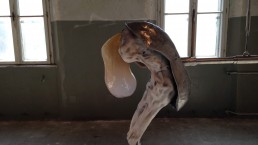
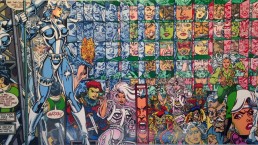
And then there is the third and last floor – the spaces here are the most run-down by far, dusty attic spaces that have yet to be repurposed but became the perfect place for Indian artist Hemali Bhuta to create her own site-specific exploration. Lost in Colour works with materials the artist brought with her from previous exhibitions and scavenge-hunts, as well as with found materials from the exhibition space itself, asking questions such as “Can we decolourize anything, and if so, how? And does decolourization mean decontamination? What would it mean to stain something, to leave a mark, to heal through staining, heal the wound of both time and memory?” (exhibition text) The October sun shone in through the many windows, revealing particles of dust in the air, intersecting with the colourless, at times stained and disturbing objects in the dirty space, evoking notions of homelessness, loss, and displacement. The word RADIONICE hung on a cloth in the space – Serbian for WORKSHOP. Bhuta’s work haunts you well into the rest of your day. It has interacted with the space and interacts with the viewer unapologetically, viscerally.
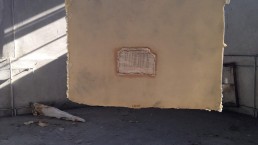
Belgrade Cultural Centre
Though the main site with the largest selection of October Salon art works was Belgrade City Museum, several others sites were also home to an impressive group of contemporary artists.
At Belgrade Cultural Centre, with three different spaces on various levels of a building in the very centre of Belgrade by Republic Square, you could find pieces by Yoko Ono, Marija Ćalić, Tørbjorn Rødland, and Ann Lislegaard, among others. Yoko Ono brought her powerful installation Arising A Call to Belgrade, inviting women all over the world to send a photograph of only their eyes, with a written testament of harm done to them for being a woman.
In the next room Marija Ćalić’s photograph series Stern-Berg, inspired by the astronomical observatory on a hill in Belgrade, evoked a kind of magical realism while merging photography of the observatory spaces with 1920s film sequences.
Another gallery space was mainly dedicated to Tørbjorn Rødland’s series of sometimes dark, sometimes humorous, and always immensely revealing photographs.
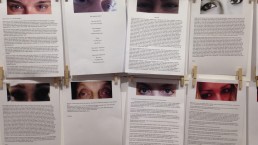
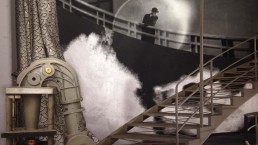
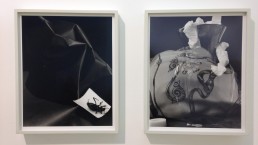
SANU Gallery
SANU Gallery, on the main Belgrade shopping street, was filled with art world legends like Cindy Sherman, Anselm Kiefer and Takashi Murakami, each contributing their own vision to the theme of The Marvellous Cacophony.
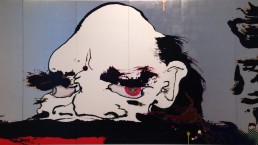
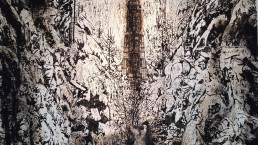
The smallest two galleries to participate in October Salon were Remont Gallery and U10 Art Space, two important spaces for contemporary art in Belgrade which have been making their mark with strong local and international contemporary art exhibitions over the years. Czech artists Eva Kot’átková and Dominik Lang took over a little room at Remont for their installation There are two in the room – and beside the room, a schedule for every day of the month, describing something changing in the room…
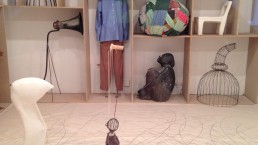
A raw, creative and complex city filled with some of the most versatile and challenging contemporary art of recent years – this was Belgrade’s 2018 October Salon. It’s an art world event you will not want to miss next year.
Profile
October Salon
Founding year
1960
Dates
15 September – 28 October, 2018
Website
Oktobarskisalon.org